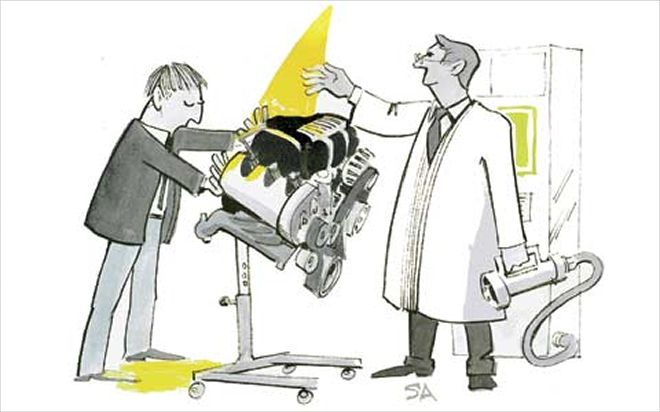Converting to PropaneQ: I own a 2004 Ford F-150, bought new in America, which I had exported to Germany. I'd like to know whether aftermarket LPG is recommended for the 5.4-liter Triton engine. Is there potential valve-seat recession or are there other problems when LPG is used? Which conversion kits does Ford offer?

| 163 0508 Ttg02 Z
A: Ford has built retail liquefied petroleum gas (propane/butane) converted F-150s, but I spoke with Rob Sharp, Ford's alternative-fuel brand manager, and he confirmed Ford's discontinuation of LPG-burning vehicles as of January 2004. There's no kit, and attempting to buy all the needed individual parts from Ford would be dollar-foolish. Production ended because of a limited market, along with the industry's pursuit of hybrid and fuel-cell technologies. Two reputable North American companies that produce conversion kits are BAF Technologies (baftechnologies.com) and TeleFlex GFI (teleflexgfi.com). I don't know of any German manufacturers that make conversion kits for your truck, but if you do find one, be careful. To prevent damage, the cylinder heads will need to be upgraded with hardened valves and valve seats. Another issue is proper management of fuel calibration. That's why finding a quality aftermarket manufacturer is necessary.
Idling Vans for WarmthQ: I'm the finance manager for a small nonprofit organization that assists the low-income elderly. Our vehicle fleet includes two Ford Econoline vans: one 2002 and one 2003 model. When one of our men arrives at the office each morning, he insists on running his truck while he's inside taking care of paperwork--we're talking 15 minutes to an hour of continuous idling. I've asked him more than once to stop this, but he hasn't. His reasons have included that the interior of the truck is cold, and that this type of vehicle has to run for a while. I'd like to be able to present an argument to our executive director in financial terms by putting a dollar figure to the wasted gas. Can you tell me how many gallons of gas are used at idle?

| 163 0508 Ttg03 Z
A: When push comes to shove, in an economical sense, idling engines produce zero mpg. Yes, diesels do burn less fuel at idle than gas-powered engines, and this may be relevant if your fleet includes the one-ton Econoline with the 7.3-liter turbodiesel. But it still may be considered wasting fuel, generating more pollutants, and adding to mechanical wear and tear on the engine. Modern diesels are more adaptive to colder climates than in the past, so cold-start problems, outside of extremely low temperatures, isn't typically a valid excuse. The question is more appropriately the value of keeping your workers warm. A full-size cargo van has a large, uninsulated interior and requires more run time to reach and maintain a comfortable temperature. Take the van to the pump and fill it up, let it idle for what you believe is the average amount of time your worker commits the transgression each day, then fill it and record the amount of fuel used. Multiply the amount by the number of cold days in the working year, and multiply that by the average price per gallon. Example: If he burns half a gallon idling per day (and it won't be that much in 15 minutes), times 150 chilly working days in the year, multiplied by $2 per gallon, it's costing you $150 a year or $12.50 per month.
Where's That Noise Coming From?Q: I have a 2003 F-250 Super Duty, and so far it's been a really good truck. However, I notice that the shocks, or what appear to be the shocks, occasionally squeak. I thoroughly washed the shocks, but they still make noise.

| 163 0508 Ttg04 Z
A: I'm assuming you're hearing a noise with the up-and-down motion of the suspension, be it a two- or four-wheel-drive F-250. There's no current technical service bulletins in relation to this type of condition on your truck, but a more common source of a squeak than shock absorbers is the set of stabilizer-bar bushings, located in the front and rear suspension. Replacement at a minimal expense can often solve the problem. It's probably best not to spend any money until you have the condition accurately diagnosed by a qualified technician. The squeak may be emanating from a number of additional components: springs, body mounts, brackets, bushings, and more.
Mysterious Gauge OutageQ: I bought a 2002 GMC Sierra HD 4x4, and the speedometer and odometer suddenly stopped working. I know it runs off a fuse, but I don't know which one. (I don't have an owner's manual.) Hours later, they started up again and then stopped. The odometer portion is lit but won't measure mileage, and the needle on the speedometer reacts only when I push the ignition key forward, but won't measure speed once the truck is moving.
A: There are three fuses (#5, #6, and #15) in the fuse block beneath the left side of the dash. These are the main power feeds to the instrument panel. Check them all, but don't get your hopes up. When a fuse burns out, the components involved don't go off and on; they stay off until the fuse is replaced and the short repaired. The powertrain control module (main computer) receives a speed signal from the vehicle speed sensor located at the transmission. It then converts the signal into useable data sent to the instrument panel. This signal, along with a good 12-volt power source and ground circuit, is what makes your speedometer and odometer function. If the fuses are working properly, the cause of the problem is elsewhere, and you're going to need professional help. The computer stores trouble codes in its memory pertaining specifically to instrument-panel failures. These codes can be a great help in diagnosis with the use of the appropriate scan tool. There are many possible causes to your problem, including, but not limited to, a defective VSS, instrument panel cluster, or PCM, or a broken circuit in the maze of wiring. If the cruise control doesn't work and the Service Engine Soon indicator has been coming on, I'd lean toward the VSS as the culprit.
I Want To Be ExhaustedQ: I want to install 21/2-inch pipes going out the back of my 2000 Silverado at 45-degree angles. What muffler will give me a good low rumble without hurting my gas mileage?
A: Borla Performance Industries (borla.com; 877/462-6752) builds quality performance exhaust systems. Its range of stainless-steel mufflers includes the Turbo, Turbo XL, and Pro XS. As with most performance-exhaust manufacturers, Borla claims its products boost power and fuel economy while delivering a forceful rumble. Call the company for advice on the optimum muffler for your truck and ask about any relevant mpg testing. Another performance part manufacturer, Banks Engineering (bankspower.com; 800/601-8072) sells a more extreme setup for GM trucks called the PowerPack system. This one incorporates nearly the entire exhaust, including manifolds, Y-pipe, and Dynaflow muffler, with a Ram-Air filter on the intake side of the engine. Again, contact tech support for assistance in evaluating advantages and pricing.
Seat Heater Fuse LocatorQ: I have a 2000 GMC Sierra 1500. Where's the fuse for the heated seats? Is there a second one that the owner's manual doesn't show?
A: There are two fuses that power the heated seat circuits for the driver and passenger seats. One is a 30-amp (SEO fuse) marked #42 in the fuse block (under the hood, near the left fenderwell). This fuse delivers 12 volts to the heating elements in the seats through individual driver and passenger seat relays. A 10-amp fuse labeled #2 (ignition fuse 3) is in the fuse block below the left side of the instrument panel. This one supplies each heated seat switch with 12 volts. When the switch is activated, voltage is directed to the appropriate relay that completes the higher amperage circuit from fuse #42 to the heating elements, Simple, right? If driver- and passenger-side heated seats are inoperable, this may indicate a loss in a common power (+) or ground (-) source, including, but not limited to, one of the fuses. One seat working would mean an uncommon component, such as a relay or a heating element in one of the seats. And, of course, the problem should be diagnosed by a professional.
Driving Through FogQ: When I drive my practically new 2004 Explorer Sport Trac in the rain and then park outside for a period of time, when the engine is restarted, the windshield fogs up excessively and takes about two minutes to clear. My dealer says this is normal for high-humidity climates, but I disagree. I've lived in the Northwest for many years, and only one other vehicle I've owned exhibited this behavior (also a Ford); it had a water leak that when fixed, solved the problem. If I can't get this problem taken care of soon (under warranty), I'll investigate invoking the lemon law. Right now, driving in the rain is just plain hazardous.
A: Every vehicle reacts differently to various climate conditions. But you want to be sure all potential causes of excessive fog have been eliminated before accepting this to be a normal characteristic of the truck. One cause could be the heater core--even slight seepage of coolant from the heater core within the heat and A/C system can cause excessive fog. Also, be sure the air-conditioning is working properly. When the system is set to the defrost mode, the A/C compressor should come on. Moisture is then removed from the air (and windshield) by condensation on the cool evaporator that is a main component of the air-conditioning system. Next, thoroughly check the vehicle for a water leak. As you've experienced before, this may produce excessive internal moisture. I've found the best way to verify a water leak on any vehicle is by pulling up the carpet at all four corners of the passenger compartment and reaching underneath to feel the insulation. If there's a significant leak, the insulation will be damp, or even soaking wet. Once a leak is verified, the carpet should be removed, the leak located and repaired, the insulation replaced, the carpet and interior thoroughly dried, and a disinfectant applied to avoid future mildew odor.

| 163 0508 Ttg05 Z
Rust Never SleepsQ:I drive a 1995 Nissan King Cab 4x4 pickup with 108,600 miles. Last week, I was washing it off at the car wash with a power sprayer, when I noticed that my frame is rusting out on the right side, just as the frame slopes down from going over the rear axle, past and beyond the leaf-spring mount. The frame rust is 1/4-inch wide, near the center of the box frame, for approximately 12 inches. I looked more closely and was able to poke a few holes with a small, sharp screwdriver. Is this fixable? The backside of the frame looks good and seems to be more solid. I have taken it into a body shop, which sent me to a shop that does steel work. The guys at the body shop said there could be liability problems if they weld it. I know my way around a shop, and I could probably weld new steel over this, but I know it's only a Band-Aid.
A:Ten-year-old truck, over 100,000 miles, rusted out frame? Junk it. The frame rail was designed as a single piece, and straying from that can cause structural weakness. A specialized engineer may be able to come up with a safe way to repair the rotted area--or perhaps a sturdy method for replacement of the entire rear section with a solid piece from a junked Nissan Pickup would make more sense. But your truck may not warrant the expense, and the steel shop noting the liability involved should be a huge red flag. If it was an old farm truck that never saw highway speeds, I'd say patch away. But there may be safety issues during normal driving and/or towing conditions. If you were happy with the truck before the rust, go price a new or pre-owned Frontier. The 2005 models show fuel economy estimates at 17 mpg city/21 highway for the 4x4 King Cab with the standard 2.5-liter engine and manual transmission. You may want to disclose the frame's condition in writing to any potential buyer of your current pickup--but selling it to a salvage yard for parts is probably the safe way to go.
 | 163 0508 Ttg02 Z
A: Ford has built retail liquefied petroleum gas (propane/butane) converted F-150s, but I spoke with Rob Sharp, Ford's alternative-fuel brand manager, and he confirmed Ford's discontinuation of LPG-burning vehicles as of January 2004. There's no kit, and attempting to buy all the needed individual parts from Ford would be dollar-foolish. Production ended because of a limited market, along with the industry's pursuit of hybrid and fuel-cell technologies. Two reputable North American companies that produce conversion kits are BAF Technologies (baftechnologies.com) and TeleFlex GFI (teleflexgfi.com). I don't know of any German manufacturers that make conversion kits for your truck, but if you do find one, be careful. To prevent damage, the cylinder heads will need to be upgraded with hardened valves and valve seats. Another issue is proper management of fuel calibration. That's why finding a quality aftermarket manufacturer is necessary.
Idling Vans for Warmth
| 163 0508 Ttg02 Z
A: Ford has built retail liquefied petroleum gas (propane/butane) converted F-150s, but I spoke with Rob Sharp, Ford's alternative-fuel brand manager, and he confirmed Ford's discontinuation of LPG-burning vehicles as of January 2004. There's no kit, and attempting to buy all the needed individual parts from Ford would be dollar-foolish. Production ended because of a limited market, along with the industry's pursuit of hybrid and fuel-cell technologies. Two reputable North American companies that produce conversion kits are BAF Technologies (baftechnologies.com) and TeleFlex GFI (teleflexgfi.com). I don't know of any German manufacturers that make conversion kits for your truck, but if you do find one, be careful. To prevent damage, the cylinder heads will need to be upgraded with hardened valves and valve seats. Another issue is proper management of fuel calibration. That's why finding a quality aftermarket manufacturer is necessary.
Idling Vans for Warmth | 163 0508 Ttg03 Z
A: When push comes to shove, in an economical sense, idling engines produce zero mpg. Yes, diesels do burn less fuel at idle than gas-powered engines, and this may be relevant if your fleet includes the one-ton Econoline with the 7.3-liter turbodiesel. But it still may be considered wasting fuel, generating more pollutants, and adding to mechanical wear and tear on the engine. Modern diesels are more adaptive to colder climates than in the past, so cold-start problems, outside of extremely low temperatures, isn't typically a valid excuse. The question is more appropriately the value of keeping your workers warm. A full-size cargo van has a large, uninsulated interior and requires more run time to reach and maintain a comfortable temperature. Take the van to the pump and fill it up, let it idle for what you believe is the average amount of time your worker commits the transgression each day, then fill it and record the amount of fuel used. Multiply the amount by the number of cold days in the working year, and multiply that by the average price per gallon. Example: If he burns half a gallon idling per day (and it won't be that much in 15 minutes), times 150 chilly working days in the year, multiplied by $2 per gallon, it's costing you $150 a year or $12.50 per month.
Where's That Noise Coming From?
| 163 0508 Ttg03 Z
A: When push comes to shove, in an economical sense, idling engines produce zero mpg. Yes, diesels do burn less fuel at idle than gas-powered engines, and this may be relevant if your fleet includes the one-ton Econoline with the 7.3-liter turbodiesel. But it still may be considered wasting fuel, generating more pollutants, and adding to mechanical wear and tear on the engine. Modern diesels are more adaptive to colder climates than in the past, so cold-start problems, outside of extremely low temperatures, isn't typically a valid excuse. The question is more appropriately the value of keeping your workers warm. A full-size cargo van has a large, uninsulated interior and requires more run time to reach and maintain a comfortable temperature. Take the van to the pump and fill it up, let it idle for what you believe is the average amount of time your worker commits the transgression each day, then fill it and record the amount of fuel used. Multiply the amount by the number of cold days in the working year, and multiply that by the average price per gallon. Example: If he burns half a gallon idling per day (and it won't be that much in 15 minutes), times 150 chilly working days in the year, multiplied by $2 per gallon, it's costing you $150 a year or $12.50 per month.
Where's That Noise Coming From? | 163 0508 Ttg04 Z
A: I'm assuming you're hearing a noise with the up-and-down motion of the suspension, be it a two- or four-wheel-drive F-250. There's no current technical service bulletins in relation to this type of condition on your truck, but a more common source of a squeak than shock absorbers is the set of stabilizer-bar bushings, located in the front and rear suspension. Replacement at a minimal expense can often solve the problem. It's probably best not to spend any money until you have the condition accurately diagnosed by a qualified technician. The squeak may be emanating from a number of additional components: springs, body mounts, brackets, bushings, and more.
Mysterious Gauge Outage
| 163 0508 Ttg04 Z
A: I'm assuming you're hearing a noise with the up-and-down motion of the suspension, be it a two- or four-wheel-drive F-250. There's no current technical service bulletins in relation to this type of condition on your truck, but a more common source of a squeak than shock absorbers is the set of stabilizer-bar bushings, located in the front and rear suspension. Replacement at a minimal expense can often solve the problem. It's probably best not to spend any money until you have the condition accurately diagnosed by a qualified technician. The squeak may be emanating from a number of additional components: springs, body mounts, brackets, bushings, and more.
Mysterious Gauge Outage | 163 0508 Ttg05 Z
Rust Never Sleeps
| 163 0508 Ttg05 Z
Rust Never Sleeps